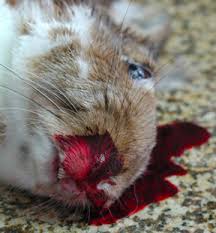Commonly Infected Wildlife
Domestic and wild rabbits of all ages.
Rabbit Hemorrhagic Disease Virus Serotype 2 (RHDV2) is a highly contagious and potentially fatal disease for rabbits — both wild and domestic. It is a foreign animal disease and is of high concern in the United States.
The most important protections against the spread of RHDV2 are:
- Eliminate contact between wild and domestic rabbits.
- Move rabbits only when absolutely necessary and in a biosecure way.

What Causes RHDV2?
RHDV2 is a virus that is spread via direct contact with infected rabbits. This leads to a contamination of their meat, fur, droppings, cages, bedding, feeder, and any other equipment that comes into contact with the infected host.
People can carry the virus on their hands, clothing, or shoes after handling an infect rabbit or its bedding, food, and other materials.
The virus can survive on an object for up to 105 days in dry environments at room temperature. The incubation period for the disease is one to five days.
Is This Animal Infected?
Often the only sign of the disease is sudden death, possibly with bloody nose caused by internal bleeding. Other signs include fever, loss of appetite, tiredness, neurologic signs, and difficulty breathing. Unexplained death of wild rabbits is suspicious.
Can I Get It?
No. RHDV2 is not known to infect people.
Safe for Pets?
No. RHDV2 can infect domestic rabbits. Although it is not known to infect other domestic animals, it is best to keep pets away from rabbit carcasses to help reduce the spread of this disease.
Protect Rabbits
- To keep the virus from spreading, follow these best practices:
- Do not allow wild rabbits to be in contact with domestic rabbits.
- House rabbits indoors if possible.
- Minimize contact with visitors who own rabbits.
- Do not handle, consume, or introduce new rabbits from unknown or untrusted sources to your home, pets, or rabbit.
- Keep pets away from sick or dead rabbits.
- Do not allow pets to eat rabbit carcasses.
- Movement of rabbits is a risk factor. A certificate of veterinary inspection is recommended and required to move domestic rabbits — especially between states. Contact your local veterinarian for information on how to get a certificate of Veterinary inspection.
- Do not, under any circumstances, release pet rabbits into the wild.
- If you find more than one dead rabbit, contact Wildlife Health at wildlifehealth@mdc.mo.gov and put “RHDV2” in the subject line.
Protect Myself and Others
To keep the virus from spreading:
- Do not handle or consume sick or dead rabbits.
- Keep pets away from sick or dead rabbits.
- Do not allow pets to eat rabbit carcasses.
The virus can be spread through contact with an infected rabbit or rabbit excretions, cages, bedding, feeders, equipment, etc. People can carry the virus on their hands, clothing, or shoes after handling an infected rabbit or its bedding, food, and other materials and then spread the virus to a healthy rabbit.
If You Find a Dead Wild Rabbit
A single dead rabbit is not cause for alarm unless there is a blood-stained nose.
- Do not handle dead rabbits.
- Report clusters of wild rabbits found dead or wild rabbits with blood-stained noses to Dr. Sherri Russell at wildlifehealth@mdc.mo.gov. Put “RHDV2” in the subject line.





















